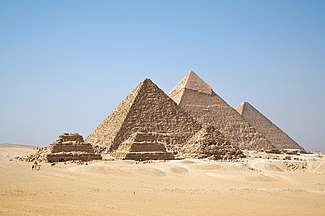Timeline of Port Said
Prior to 20th century
Part of a series on the |
||||||||||||||||||
|---|---|---|---|---|---|---|---|---|---|---|---|---|---|---|---|---|---|---|
| History of Egypt | ||||||||||||||||||
 | ||||||||||||||||||
|
||||||||||||||||||
|
||||||||||||||||||
|
||||||||||||||||||
|
||||||||||||||||||
|
||||||||||||||||||
|
||||||||||||||||||
|
| ||||||||||||||||||
- 1859
- 1861 - Population: 4,000.[2]
- 1863 - Sweet Water Canal built.
- 1869
- Lighthouse of Port Said begins operating.
- November: Suez Canal opens.
- 1870 - Coal heaving porters guild established.[3]
- 1870s - Anti-European unrest.[4]
- 1881 - Abbas Mosque commissioned (built later).[5]
- 1883 - Population: 17,000.[6]
- 1895 - Headquarter of the Suez Canal Authority in Port Said built.[7]
- 1899 - De Lesseps statue unveiled on Jetee Ouest (pier).[6]
20th century
- 1904 - Cairo-Port Said railway begins operating.
- 1917 - Russian battleship Peresvet sinks offshore.
- 1920 - Al-Masry Sporting Club formed.
- 1926
- Port Fouad founded on opposite side of Suez Canal.
- Catholic Diocese of the Canal of Suez established.[8]
- 1947 - Population: 177,703.[9]
- 1955 - Port Said Stadium opens.
- 1956
- 5 November: British and French forces arrive during Suez Crisis.[10]
- 23 December: British and French troops depart.[10]
- December: Moorhouse Affair.
- 1960 - Population: 244,000.[11]
- 1967 - After Israeli forces occupy Sinai Peninsula, some residents begin to flee city.[12]
- 1974 - Population: 342,000.[13]
- 1976
- Suez Canal University established.
- Port Said declared a duty-free port.
- 1992 - Population: 460,000 (estimate).[14]
- 1995 - Museum of Modern Art opens.
- 1998 - History Gardens laid out.[15]
- 1999 - Port Said Hall (arena) opens.
21st century
- 2004
- Suez Canal Container Terminal begins operating.
- Misr Public Library inaugurated.
- 2005 - Port Said International School opens.
- 2008
- December: 2008 Arab Futsal Championship held.
- Population: 588,938.[1]
- 2010
- Port Said University established.
- Population: 603,787.
- 2012 - 1 February: Port Said Stadium riot.[16]
- 2013
- 2017 - Population: 749,371 (urban agglomeration).[17]
gollark: Is there a way to export reactor designs from https://animusfracto.github.io/NC-reactor-app/fission?
gollark: I think I remember seeing some screenshots of an early version on here.
gollark: Did that web-based reactor planner thing someone was working on ever get written?
gollark: When I say "JS" I mean web-based.
gollark: I should really make a JS version of the planner one of these days.
See also
- History of Port Said
- Timelines of other cities in Egypt: Alexandria, Cairo
- Timeline of Egypt
References
- Historical Dictionary of Egypt. Scarecrow Press. 2013. ISBN 978-0-8108-8025-2.
- Jean-Paul Calon (1997). "Suez Canal revisited: 19th century global infrastructure". Macro-Engineering: MIT Brunel Lectures on Global Infrastructure. Woodhead. p. 11. ISBN 978-1-78242-057-6.
- John Chalcraft (2001). "Coal Heavers of Port Sa'id: State-Making and Worker Protest, 1869-1914". International Labor and Working-Class History (60): 110–124. JSTOR 27672741.
- Juan R. I. Cole (1989). "Of Crowds and Empires: Afro-Asian Riots and European Expansion, 1857-1882". Comparative Studies in Society and History. 31 (1): 106–133. doi:10.1017/S0010417500015681. JSTOR 178796.
- Fassil Demissie, ed. (2012). Colonial Architecture and Urbanism in Africa: Intertwined and Contested Histories. Ashgate. ISBN 978-0-7546-7512-9.
- "Port Said", Egypt and the Sudan (7th ed.), Leipzig: Karl Baedeker, 1914
- Edmond coignet
- "Chronology of Catholic Dioceses: Egypt". www.katolsk.no. Norway: Oslo katolske bispedømme (Oslo Catholic Diocese). Retrieved 30 January 2015.
- "Population of capital city and cities of 100,000 or more inhabitants". Demographic Yearbook 1955. New York: Statistical Office of the United Nations.
- "Timeline: The Suez Crisis". BBC News. 18 July 2006.
- Janet L. Abu-Lughod (1965). "Urbanization in Egypt: Present State and Future Prospects". Economic Development and Cultural Change. 13 (3): 313–343. doi:10.1086/450113. JSTOR 1152248.
- Mohamed Abdel Shakur; et al. (2005). "War and forced migration in Egypt: the experience of evacuation from the Suez Canal cities (1967-1976)". Arab Studies Quarterly. 27 (3): 21–39. JSTOR 41858507.
- United Nations Department of Economic and Social Affairs, Statistical Office (1976). "Population of capital city and cities of 100,000 and more inhabitants". Demographic Yearbook 1975. New York. pp. 253–279.
- United Nations Department for Economic and Social Information and Policy Analysis, Statistics Division (1997). "Population of capital cities and cities of 100,000 and more inhabitants". 1995 Demographic Yearbook. New York. pp. 262–321.
- Egypt: Port Said, ArchNet, archived from the original on 29 October 2013
- Encyclopædia Britannica Book of the Year. 2013. ISBN 978-1-62513-103-4.
- "Table 8 - Population of capital cities and cities of 100,000 or more inhabitants", Demographic Yearbook – 2018, United Nations
This article incorporates information from the Spanish Wikipedia.
External links
| Wikimedia Commons has media related to Port Said. |
- Digital Public Library of America. Items related to Port Said, various dates
This article is issued from Wikipedia. The text is licensed under Creative Commons - Attribution - Sharealike. Additional terms may apply for the media files.